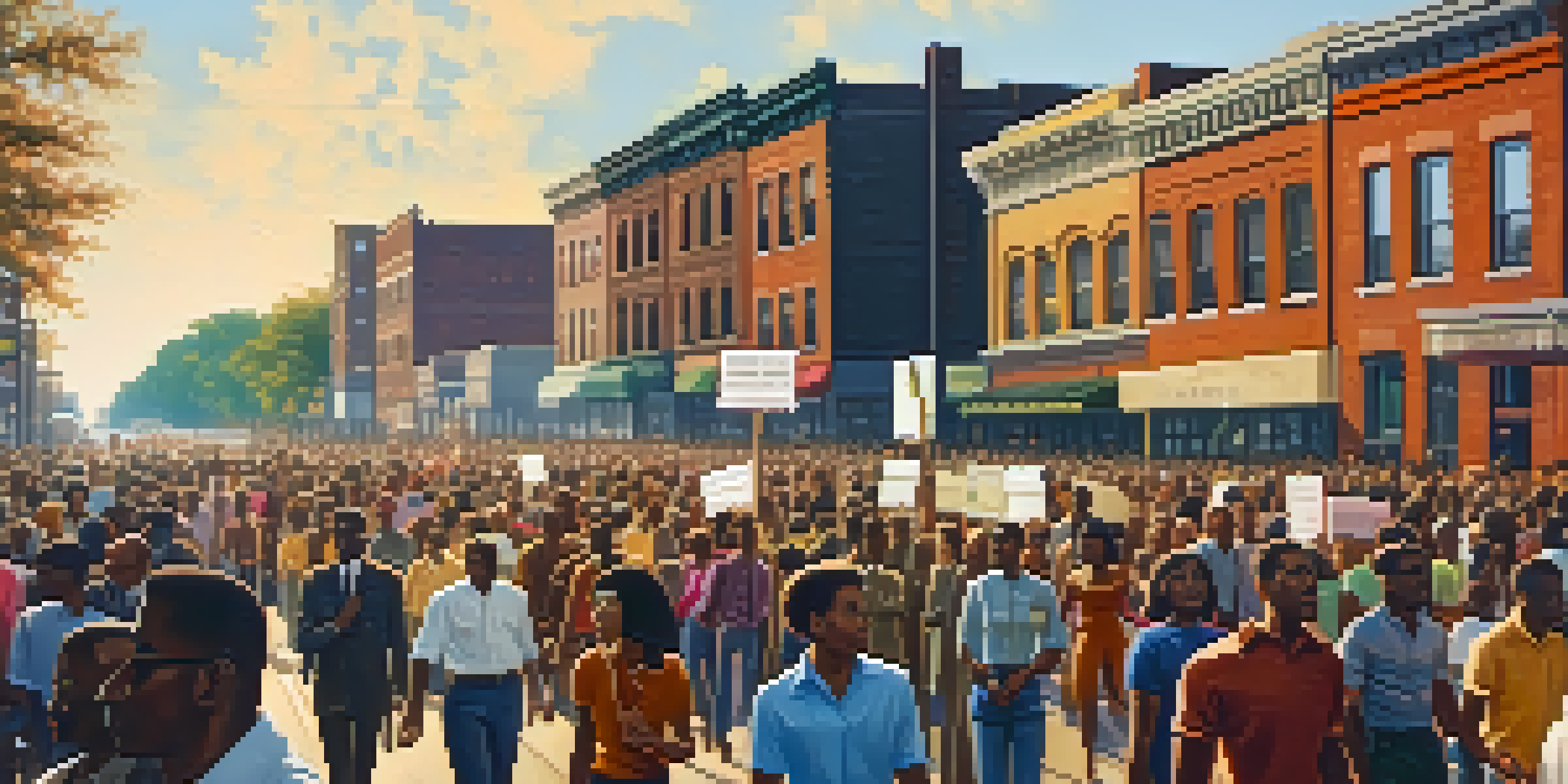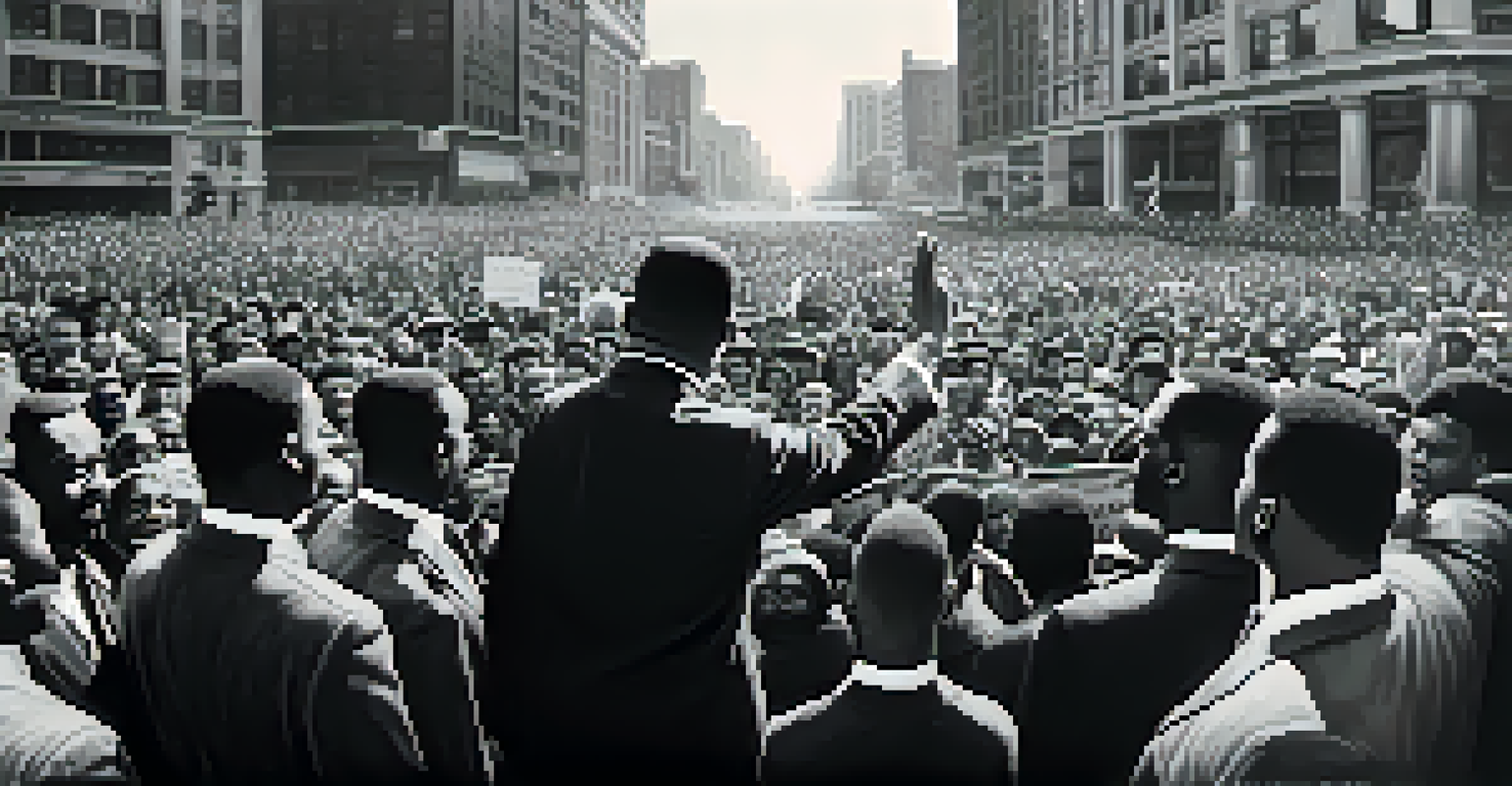Chicago's Role in the Civil Rights Movement

The Roots of Civil Rights in Chicago: A Historical Overview
Chicago's journey in the Civil Rights Movement can be traced back to the early 20th century, when the city became a hub for African American migration. The Great Migration brought countless individuals seeking better opportunities and escaping the harsh realities of the Jim Crow South. This influx of people began to reshape Chicago's social landscape, laying the groundwork for a burgeoning civil rights movement.
Injustice anywhere is a threat to justice everywhere.
As African Americans settled in neighborhoods like Bronzeville, they formed tight-knit communities that fostered cultural expression and activism. Local organizations began to emerge, addressing issues like discrimination, housing inequality, and employment opportunities. These grassroots initiatives were pivotal in mobilizing the community and igniting a collective desire for change.
By the mid-20th century, Chicago had become a focal point for civil rights activism, with many leaders and organizations calling it home. This vibrant scene not only amplified local voices but also connected Chicago to national movements, establishing the city as a critical player in the fight for equality.
Key Figures: Activists Who Shaped Chicago's Movement
Among the many influential figures in Chicago's Civil Rights Movement, Martin Luther King Jr. stands out for his pivotal role in the city during the 1960s. His visits to Chicago were not just symbolic; they were a call to action aimed at uniting the community against systemic racism. King's leadership during the Chicago Freedom Movement shed light on the desperate need for housing reforms and fair employment practices.

Another notable figure is Harold Washington, who would later become Chicago's first Black mayor. Washington's early activism and community organizing helped galvanize support for civil rights legislation and fair housing. His journey from activist to politician showcased the potential for change through both grassroots efforts and formal governance.
Chicago's Civil Rights Roots
The Great Migration transformed Chicago into a vital center for African American activism and cultural expression.
Additionally, organizations like the Congress of Racial Equality (CORE) and the Chicago Urban League played crucial roles in advocating for civil rights. These groups worked tirelessly to combat discrimination and promote equality, often collaborating with national movements to amplify their impact. Their efforts exemplified the power of collective action in the fight for justice.
The Chicago Freedom Movement: A Turning Point
The Chicago Freedom Movement, launched in 1966, marked a significant turning point in the city's civil rights struggle. Spearheaded by Martin Luther King Jr. and local activists, this movement aimed to address deep-seated issues such as housing discrimination and economic inequality. It brought thousands of residents together in a series of protests, marches, and sit-ins that highlighted the urgent need for change.
The time is always right to do what is right.
One of the most notable events during this period was the march through Chicago's white neighborhoods, which aimed to confront segregation head-on. The visuals of King and his supporters marching through hostile areas were powerful and served as a stark reminder of the pervasive racism that still existed. This bold action not only garnered media attention but also sparked conversations about race relations across the nation.
Despite facing significant opposition, the Chicago Freedom Movement laid the foundation for important reforms in housing and community development. It illustrated the strength of local activism and demonstrated that change was possible through perseverance and solidarity. The movement's legacy continues to inspire future generations to advocate for social justice.
Housing Discrimination: The Fight for Fairness
Housing discrimination was a major issue that activists tackled head-on during the Civil Rights Movement in Chicago. The practice of redlining, where banks and insurers denied services to predominantly Black neighborhoods, perpetuated cycles of poverty and segregation. Activists recognized that access to decent housing was a fundamental right, crucial for achieving broader equality.
The struggle for fair housing gained momentum during the Chicago Freedom Movement, culminating in the Fair Housing Ordinance of 1968. This landmark legislation aimed to eliminate discrimination in housing and ensure that all citizens had equal access to homes. The passage of this law was a hard-fought victory, resulting from years of protests and persistent advocacy from community leaders.
Key Activists and Their Impact
Influential figures like Martin Luther King Jr. and Harold Washington played crucial roles in advancing civil rights and community organizing.
However, the fight did not end with legislation; enforcement remained a significant challenge. Activists continued to monitor and challenge discriminatory practices in housing, emphasizing the importance of vigilance in the ongoing struggle for equality. This ongoing commitment serves as a reminder that achieving social justice requires continuous effort and community engagement.
Educational Initiatives: Empowering the Next Generation
Education has always been a cornerstone of the Civil Rights Movement, and Chicago was no exception. Activists understood that empowering the younger generation with knowledge was vital to fostering future leaders in the fight for equality. Various initiatives were launched to promote civil rights education and raise awareness about social issues affecting the community.
Programs such as the Chicago Freedom Schools provided students with a curriculum focused on civil rights history and social justice. These schools aimed to cultivate critical thinking and instill a sense of responsibility in students, encouraging them to become active participants in their communities. By emphasizing the importance of education, these initiatives sought to create a more informed and engaged citizenry.
Moreover, local universities and colleges played a pivotal role in shaping the discourse around civil rights. Students often organized rallies, sit-ins, and workshops to address discrimination and promote equality on campus and beyond. This intergenerational collaboration highlighted the importance of education as a tool for activism, ensuring that the fight for civil rights would continue into the future.
The Role of Media: Amplifying Voices and Stories
Media played a crucial role in shaping public perception of the Civil Rights Movement in Chicago. Local newspapers, radio stations, and television broadcasts helped to amplify the voices of activists and highlight the injustices faced by African Americans. This coverage not only informed the public but also galvanized support for the movement, creating a sense of urgency around the issues at hand.
The rise of television in the 1960s allowed for powerful visual storytelling, bringing the realities of segregation and discrimination directly into people's living rooms. Iconic images of protests, marches, and confrontations with law enforcement captured the nation's attention and sparked conversations about race and justice. This unprecedented exposure contributed to the growing awareness and support for civil rights initiatives across the country.
Ongoing Legacy of Activism
The struggles and victories of Chicago's Civil Rights Movement continue to inspire contemporary efforts for social justice and equality.
Social media has since transformed how movements communicate and organize, yet the fundamental importance of media remains. The legacy of Chicago's civil rights activists serves as a reminder that storytelling and visibility are integral to creating meaningful change. By sharing their experiences and struggles, activists continue to inspire new generations to stand up for justice.
Legacy and Impact: Reflecting on Chicago's Civil Rights Movement
The legacy of Chicago's Civil Rights Movement is profound, with its impact still felt today. The struggles and victories of activists have paved the way for ongoing discussions about race, equality, and justice in America. This historical context is crucial for understanding the challenges that persist and the work that still needs to be done.
Many of the organizations and leaders from this era have inspired contemporary movements advocating for social justice. The principles of community organizing, grassroots activism, and coalition-building that emerged during the Civil Rights Movement continue to influence today's advocacy efforts. This interconnectedness underscores the importance of learning from history to inform current strategies.

As Chicago grapples with issues of inequality and discrimination, the lessons from its Civil Rights Movement remain relevant. The resilience and determination of those who fought for change serve as a powerful reminder that the pursuit of justice is an ongoing journey. By honoring this legacy, we can work towards a more equitable future for all.